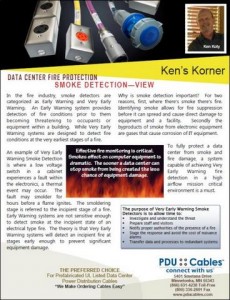KEN'S KORNER - Fire Protection - Smoke Detection - VIEW
 Click here to view, print and share a pdf of this article.[/caption]
Click here to view, print and share a pdf of this article.[/caption]
Data Center - Fire Protection - Smoke Detection - VIEW
In the fire industry, smoke detectors are categorized as Early Warning and Very Early Warning. An Early Warning system provides detection of fire conditions prior to them becoming threatening to occupants or equipment within a building, while Very Early Warning systems are designed to detect fire conditions at the very earliest stages of a fire.
An example of Very Early Warning Smoke Detection is where a low voltage switch in a cabinet experiences a fault within the electronics, a thermal event may occur. The fault may smolder for hours before a flame ignites. The smoldering stage is referred to the incipient stage of a fire. Early Warning systems are not sensitive enough to detect smoke at the incipient state of an electrical type fire. The theory is that Very Early Warning systems will detect an incipient fire at stages early enough to prevent significant equipment damage.
Effective fire monitoring is critical. Smoke effect on computer equipment is dramatic. The sooner a data center can stop smoke from being created the less chance of equipment damage.
Why is smoke detection important? For two reasons, first, where there’s smoke there’s fire. Identifying smoke allows for fire suppression before it can spread and cause direct damage to equipment and a facility. Secondly the byproducts of smoke from electronic equipment are gases that cause corrosion of IT equipment.
To fully protect a data center from smoke and fire damage, a system capable of achieving Very Early Warning fire detection in a high airflow mission critical environment is a must.
The purpose of Very Early Warning Smoke Detectors is to allow time to:
• Investigate and understand the threat
• Prepare staff and visitors
• Notify proper authorities of the presence of a fire
• Stage the response and avoid the cost of nuisance alarms
• Transfer data and processes to redundant systems
Very Intelligent VIEW
Previously we talked about active smoke detection for a mission critical facility using the Very Early Smoke Detection Apparatus (VESDA). Now we’d like to discuss an alternate method of smoke detection using the Very Intelligent Early Warning smoke detector (VIEW), a passive smoke detection system.
The VIEW detector uses a very bright laser LED to detect smoke in the detector chamber. When a particle of combustion crosses the light beam it causes the light to scatter which signals an alarm condition.
The VIEW detector can sense a slow smoldering fire as well as a fast flaming fire and can react up to 100 times faster than a standard photoelectric smoke detector. Because of the extremely bright laser diode and the precision optics, the VIEW detector rivals the aspiration detectors (VESDA) in response time. Smoke density can be set as low as 0.02%. The user can select from 9 sensitivity levels form 0.02% to 2.00% for either pre-alarm or alarm notification. This flexibility gives the user a wide range of options for any type of situation/ room configuration.
Uptime is paramount in mission critical facilities. Therefore the earliest detection and warning of a potential fire allows for investigation and intervention to prevent damage, downtime, or unwanted agent release. The earliest warning of an impending fire situation can lower the risk of potential downtime or loss to a minimum and is a critical component in the design of a Mission Critical facility.
The VIEW detector makes a distinction between actual smoke particle and dust particles by utilizing advanced algorithms to determine physical make-up of the contaminant entering the chamber. This design eliminates false alarms and presents a true reading of actual fire events in the protected area.
VIEW also uses advanced algorithms to detect and ignore transient “spikes”. If a detector registers a large signal spike it immediately compares that reading to the two previous readings. The detector than compares the readings and uses the lowest of the last three readings to determine of a smoke condition is present. If not the detector will ignore one or two transient spikes.
Unlike standard area smoke detection which has a listing of 900 square foot coverage. The VIEW detector is rated at a listing of 200 square foot coverage. This is as defined in NFPA 318, Standard for Protection of Clean Rooms. The reduced spacing requirements as well as the unique addressing of each smoke detector allows pinpoint annunciation of the exact fire location.
VIEW is used frequently in what used to be an aspiration detection application only. Due to the fast response time, low cost and flexibility of the VIEW detector, it has become a viable alternate to VESDA. Both smoke detection systems are viable and both are used extensively in Mission Critical facilities.
Special thanks to Bob Hoertsch a Fire Alarm and Detection System Specialist with Low Voltage Contractors (www.lvcinc.com) for his assistance with this article.
Ken Koty,
